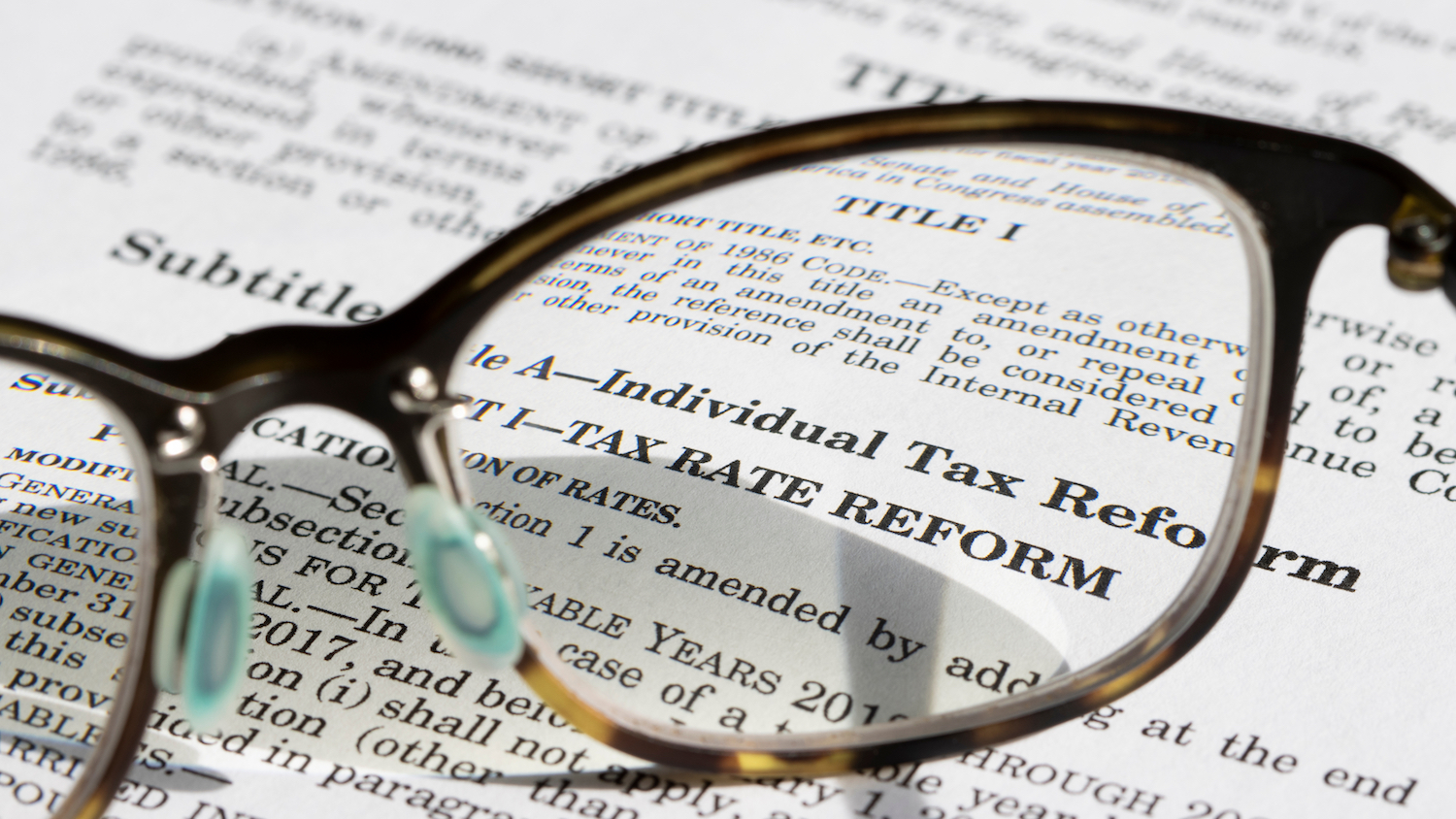Tax Law Changes Are On The Ballot
The outcome of the 2024 presidential election could determine the future of a bevy of personal and corporate tax cuts.

In 2017, then-President Donald Trump’s administration passed the Tax Cuts and Jobs Act (TJCA), one of the largest overhauls of the U.S. tax code in history. Many of the TJCA’s tax cuts and tax-reducing provisions came with “sunset” provisions, which set dates when tax rates would revert to their previous levels. The sunsets were put in place because many of these provisions had substantial tax revenue costs. For budgetary reasons, lawmakers didn’t want to make the tax-reducing provisions permanent. Many of those sunset dates will occur during the next presidential term.
The current federal debt is around $35 trillion and the current TJCA provisions would add an estimated $3-4 trillion to the federal debt over the next decade. Lawmakers will have to carefully weigh the pros and cons of extending tax cuts. Here’s a rundown of the TCJA’s key provisions and the two presidential candidates’ positions on them:
Individual Tax Rates
Prior to the TJCA, individual tax rates ranged from 10 to 39.6 percent, with the top tax bracket—the income threshold that triggers the top tax rate—being around $418,000 for single taxpayers and $470,000 for married couples. The income thresholds are indexed for inflation annually.
The TCJA reduced the top individual tax rate to 37 percent and increased the income thresholds for the top tax bracket to $500,000 (single taxpayers) and $600,000 (married couples), both of which resulted in a non-trivial tax cut for higher-income taxpayers.
If policymakers do nothing, the top rate will revert back to 39.6 percent in 2026. As of 2024, the top tax brackets start around $609,000 for single taxpayers and $730,000 for married couples. These income thresholds would also likely revert back to somewhere around $400,000.
Vice President Kamala Harris, the Democratic presidential candidate, favors pushing the top tax rate back to 39.6 percent for taxpayers making more than $400,000 and married couples earning more than $450,000. She has promised not to raise tax rates on taxpayers earning less than $400,000. On the other hand, Republican nominee Trump favors extending the tax cut provisions.
Standard and Itemized Deductions
The TCJA also significantly changed how standard and itemized deductions work. When they file their personal income taxes, U.S. taxpayers can reduce their tax burden by choosing either the standard deduction—a flat amount subtracted from their total taxable income —or itemized deductions—separate deductions for money spent on a range of expenses, including state and local taxes, mortgage interest and charitable contributions. Taxpayers generally choose to itemize if their total deductions exceed the standard deduction.
The TJCA nearly doubled the standard deductions, from $6,350 to $12,000 for single taxpayers and $12,700 to $24,000 for married couples. Inflation adjustments have brought current levels to $16,500 for single taxpayers and $29,200 for married couples. If lawmakers do nothing, the standard deduction will fall by roughly half in 2026.
Keeping the higher standard deduction comes with trade-offs. On one hand, it makes tax filing much less cumbersome for many lower-income taxpayers. On the other hand, it would be costly. The Congressional Budget Office (CBO) estimates it would cost around $1.3 trillion over the next decade, which could increase an already-large federal deficit.
Trump supports extending the higher standard deduction. Harris’s pledge not to raise taxes on those earning less than $400,000 suggests she would also likely support extending the higher standard deductions, at least for people below that threshold.
Lawmakers use itemized deductions to incentivize economic behaviors by making them tax-deductible. A high standard deduction can discourage those behaviors. For example, if taxpayers can deduct mortgage interest and property taxes, they may more incentive to purchase a home versus renting. Currently, less than 10 percent of taxpayers itemize their deductions. If the standard deduction reverts back to its lower level, that number could climb to 30 percent.
While the TCJA increased the standard deduction, it also capped deductible state and local taxes (SALT) at $10,000. Previously, there was no limit on how much SALT taxpayers could deduct. If lawmakers do nothing, the SALT cap will also go away. That would be especially beneficial for taxpayers in high-tax states such as New York and California, but it would also reduce tax revenue, which could be detrimental to federal deficits.
It’s not clear what Harris plans to do with the SALT cap, but many fellow Democrats have opposed it. Trump advocates removing the cap while extending other TJCA provisions.
Child Tax Credit
There could be change on the horizon for the child tax credit. The federal tax code has traditionally included a dollar-for-dollar reduction in a taxpayer’s tax bill for each child under 17 in their household. The TCJA increased the child tax credit from $1,000 to $2,000 per child.
Children are expensive, and a higher child tax credit would make the individual tax more horizontally equitable, meaning that taxpayers with different cash flow situations pay at different levels. But that equity would come at a cost. The CBO estimates that extending the higher tax credit through 2034 would cost around $748 billion.
Trump favors extending the higher child tax credit. His running mate, U.S. Sen. J.D. Vance, has suggested raising it to $5,000.
Harris wants to increase the child tax credit to $6,000 for newborns, $3,600 for children under 6 years old, and $3,000 for children between 6 and 17. She’d also make it refundable, which could mean payments to taxpayers with no tax liability. This change would also expand the benefit to low-income families who do not pay any tax.
Corporate Tax Rates
The TJCA instituted a flat rate of 21 percent, replacing a progressive rate that ranged from 15 to 38 percent. This was a substantial rate cut for U.S. corporations. Before the TCJA, the U.S. had one of the highest corporate tax rates in the world. Most of the corporate tax provisions of the TCJA do not sunset, so they’ll stay the same if lawmakers do nothing.
Harris supports increasing the corporate tax rate to 28 percent. Trump, on the other hand, has proposed cutting it to 15 percent for domestic manufacturers.
Both sides should proceed cautiously with the corporate tax rate. A further corporate rate cut would obviously be good for U.S. companies. It could also increase the federal deficit. The key question is whether a corporate rate cut would stimulate significant new economic activity. If it doesn’t, the benefits are unlikely to outweigh the lost tax revenue.
Those who want to see corporations pay their “fair share” via a higher tax rate should bear in mind that corporations are collections of individual owners. When the corporate tax rate goes up, corporate managers can shift the burden to other stakeholders. lower wages to employees and higher prices to customers. That means employees and customers could bear the cost via lower wages and higher prices.
Deductions for Small Businesses
The TCJA cut the corporate tax rate more than the individual rate. To level the playing field, it also included a special deduction for small business owners. The Qualified Business Income (QBI) deduction allows them to deduct up to 20 percent of net qualifying income. For example, if a small business owner had a net income of $100,000, they would receive a deduction equal to 20 percent, resulting in a taxable income of $80,000. This deduction is phased out for taxpayers who earn between $300,000 and $500,000.
If lawmakers do nothing, the QBI deduction will go away at the end of 2025. It’s possible that individual tax rates will increase to 39.6 percent, corporate tax rates will remain low, and small business owners will be disproportionately worse off.
Trump favors extending the current QBI deduction. Harris proposes replacing the QBI deduction with something similar to the individual standard deduction. She’d have small business owners report gross income and then deduct a set portion of that income to arrive at taxable income.
A note on Harris’s proposal: It would simplify the tax compliance process for small business owners. However, it might reduce equity overall because all businesses would receive the same deduction percentage regardless of how much actual business expense they incur. For example, a business owner with $100,000 of gross receipts and no business expenses would owe the same level of tax as one who had $100,000 in gross receipts and $100,000 in expenses (i.e., a net income of zero).
If Harris is elected, lawmakers should carefully consider the pros and cons of this proposal, as well as whether they could make it an optional standard deduction, allowing business owners to either take the standard deduction or “itemize” their business expense deductions, like the choice individuals have to take the standard deduction or itemize qualified expenses.
Net Operating Loss Deductions
The TCJA changed how businesses can use net operating losses (NOLs) to offset profits in past years. Prior to the TCJA, businesses could carry 100 percent of their current NOL back to the two previous years. For example, if a business had a $100,000 loss in the current year but $50,000 of profit in each of the past two years, they could carry the loss back to get refunds for taxes paid on $100,000 of income ($50,00K per year).
The TCJA got rid of the carryback provision, so NOLs can only offset future income. The TCJA also limits future-year NOL deductions to 80 percent of the income in the profit year. So, if the business in our example had a $100,000 loss in year one and a $100,000 profit in year two, it could reduce its year-two tax burden by $80,000 (80 percent of the loss in year one).
If lawmakers do nothing, the tax treatment of NOLs will revert to pre-TCJA rules.
Harris hasn’t taken a public position on the TCJA’s NOL provisions. Trump wants to extend them.
Closing Thoughts
The presidential election has significant implications for federal tax law, and especially for these TCJA provisions. We urge policymakers to carefully weigh the pros and cons of tax changes, especially tax decreases that could have a big impact on federal deficits and the federal debt. It’s appealing to propose lower taxes because no one likes paying more money to the government. But the federal debt has increased from around $18 trillion to $35 trillion over the past decade, and tax breaks have played a role in increasing deficits and the overall federal debt.
Christina Lewellen is an associate professor of accounting in the Poole College of Management.


Nathan Goldman is an associate professor of accounting in the Poole College of Management.
- Categories:


